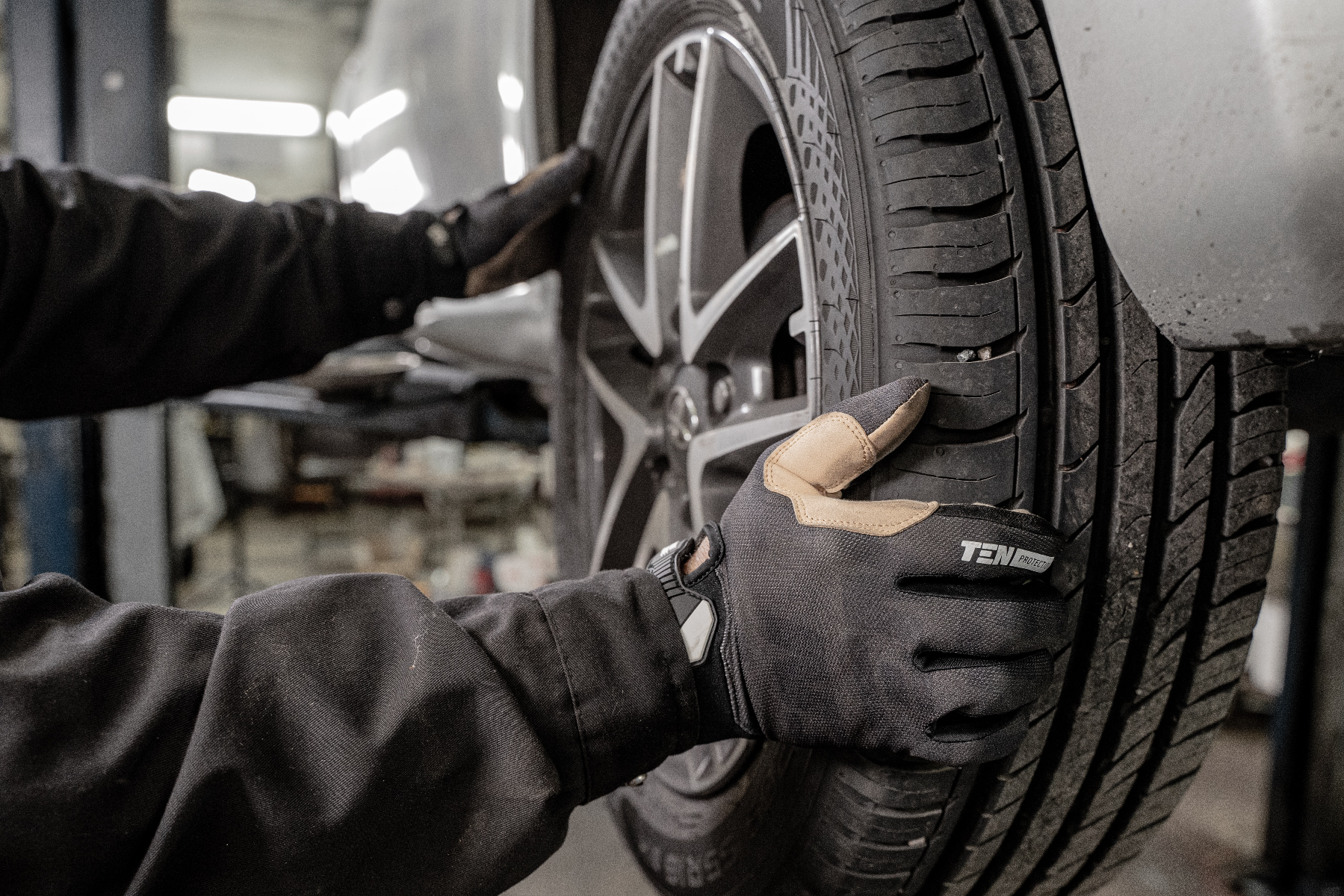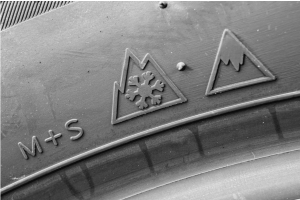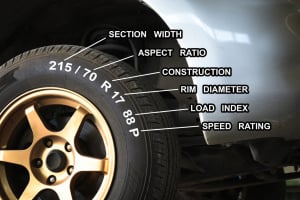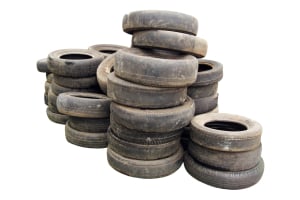 According to the National Highway Traffic Safety Administration (NHTSA), when people drive on underinflated tires, it increases their risk of getting into an accident by 300 percent. In addition, overinflation can significantly impact a tire’s performance. This means drivers must pay attention to their vehicle’s tire pressure before hitting the road. What Should My Tire Pressure Be? The recommended tire pressure for each vehicle will vary depending on the manufacturer’s recommendation. Car manufacturers have calculated the correct pressure after running numerous tests. You should check the sticker or card at the driver’s door to find the correct levels for your tires. You can also find this information in your owner’s manual. The recommended pressure levels usually range from 32 to 40 pounds per square inch (PSI). Most tires will have their PSI rating indicated on the side. Remember that this number indicates the maximum pressure the tire can take. Therefore, the recommended pressure level will be based on the size of your vehicle and the type of tire you’re using. Checking Your Tire’s PSI Levels
According to the National Highway Traffic Safety Administration (NHTSA), when people drive on underinflated tires, it increases their risk of getting into an accident by 300 percent. In addition, overinflation can significantly impact a tire’s performance. This means drivers must pay attention to their vehicle’s tire pressure before hitting the road. What Should My Tire Pressure Be? The recommended tire pressure for each vehicle will vary depending on the manufacturer’s recommendation. Car manufacturers have calculated the correct pressure after running numerous tests. You should check the sticker or card at the driver’s door to find the correct levels for your tires. You can also find this information in your owner’s manual. The recommended pressure levels usually range from 32 to 40 pounds per square inch (PSI). Most tires will have their PSI rating indicated on the side. Remember that this number indicates the maximum pressure the tire can take. Therefore, the recommended pressure level will be based on the size of your vehicle and the type of tire you’re using. Checking Your Tire’s PSI Levels  After determining a tire’s recommended PSI, you can measure its current pressure level to ensure that they’re in good shape and still roadworthy. You’ll need an air compressor and a tire pressure gauge to check the pressure. You can find these tools in gas stations and mechanic shops. Follow these steps to check the PSI levels of your car’s tires: 1. Test PSI Levels When The Tires Are Cool The PSI levels of your tires will change according to the tire’s temperature. Notice that your owner’s manual usually indicates cold inflation pressure. When you get to the mechanic’s shop or gas station, wait until your tires have cooled off. It may take several hours before a car’s tires are completely cool. On the other hand, if you have a gauge, it is best to measure the pressure before you drive to your destination. 2. Measure PSI Levels Using a Pressure Gauge Regular pressure gauges will look like a metal tube with a bar that gets pushed out by the air from the tire valve. Other gauges have a dial to indicate pressure levels, and you can also find digital pressure gauges, which can be more pricey than regular ones. To check the pressure of each tire, unscrew the valve cap and press the gauge into the stem. Make sure you’re pushing hard enough, so the hissing sound from the valve stops. The gauge only takes a couple of seconds to get a reading. Take note of the readings of each tire. 3. Fill the Tires With Air According to the Recommended PSI
After determining a tire’s recommended PSI, you can measure its current pressure level to ensure that they’re in good shape and still roadworthy. You’ll need an air compressor and a tire pressure gauge to check the pressure. You can find these tools in gas stations and mechanic shops. Follow these steps to check the PSI levels of your car’s tires: 1. Test PSI Levels When The Tires Are Cool The PSI levels of your tires will change according to the tire’s temperature. Notice that your owner’s manual usually indicates cold inflation pressure. When you get to the mechanic’s shop or gas station, wait until your tires have cooled off. It may take several hours before a car’s tires are completely cool. On the other hand, if you have a gauge, it is best to measure the pressure before you drive to your destination. 2. Measure PSI Levels Using a Pressure Gauge Regular pressure gauges will look like a metal tube with a bar that gets pushed out by the air from the tire valve. Other gauges have a dial to indicate pressure levels, and you can also find digital pressure gauges, which can be more pricey than regular ones. To check the pressure of each tire, unscrew the valve cap and press the gauge into the stem. Make sure you’re pushing hard enough, so the hissing sound from the valve stops. The gauge only takes a couple of seconds to get a reading. Take note of the readings of each tire. 3. Fill the Tires With Air According to the Recommended PSI  After taking note of the readings of each tire, you should reduce or add air to each tire accordingly. Add more air to underinflated tires until they reach the recommended PSI levels. Remove air from tires that have too much pressure. Note that the recommended PSI levels for some vehicles will be different for the front and rear tires. If your tires are still hot while adding air, it is best to inflate them up to three to four PSI levels higher than recommended. After giving your tires sufficient time to cool down, you can recheck the pressure levels. It’s okay to overinflate your tires slightly since letting the air out of a tire valve is easy. After adding or removing air from your car’s tires, recheck the PSI levels. After that, you can drive your vehicle to your destination. Maintaining Tire PSI Levels It is best to check the PSI levels of your car’s tires every two to four weeks. In addition, check the pressure levels if you’re going on a long drive or if you’re loading a lot of items in your car. Some vehicles have tire pressure monitoring systems (TPMS) that alert you when the PSI levels drop. Note that this tool isn’t perfect, and sometimes it can’t tell you which tires are underinflated. Some TPMS systems are programmed to prevent cars from starting if it detects underinflated tires. Even if your car doesn’t have a TPMS system, checking your vehicle’s tire pressure will improve its fuel efficiency. Drivers should routinely check their tires for recommended PSI levels. In addition, having correctly inflated tires keeps you safe on the road. If your tires are low on pressure and the tread is getting thin, check out our new tires search here.
After taking note of the readings of each tire, you should reduce or add air to each tire accordingly. Add more air to underinflated tires until they reach the recommended PSI levels. Remove air from tires that have too much pressure. Note that the recommended PSI levels for some vehicles will be different for the front and rear tires. If your tires are still hot while adding air, it is best to inflate them up to three to four PSI levels higher than recommended. After giving your tires sufficient time to cool down, you can recheck the pressure levels. It’s okay to overinflate your tires slightly since letting the air out of a tire valve is easy. After adding or removing air from your car’s tires, recheck the PSI levels. After that, you can drive your vehicle to your destination. Maintaining Tire PSI Levels It is best to check the PSI levels of your car’s tires every two to four weeks. In addition, check the pressure levels if you’re going on a long drive or if you’re loading a lot of items in your car. Some vehicles have tire pressure monitoring systems (TPMS) that alert you when the PSI levels drop. Note that this tool isn’t perfect, and sometimes it can’t tell you which tires are underinflated. Some TPMS systems are programmed to prevent cars from starting if it detects underinflated tires. Even if your car doesn’t have a TPMS system, checking your vehicle’s tire pressure will improve its fuel efficiency. Drivers should routinely check their tires for recommended PSI levels. In addition, having correctly inflated tires keeps you safe on the road. If your tires are low on pressure and the tread is getting thin, check out our new tires search here.
What Should My Ideal Tire Pressure Be?
Posted: September 16, 2022
Categories: Blog





